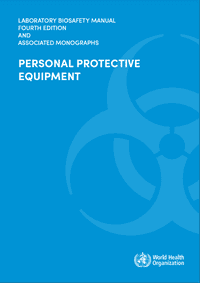LBM, 4th Edition: Personal Protective Equipments Monograph
[LBM 4: Personal Protective Equipment]
One of seven monographs associated with the 4th edition of the WHO LBM. This monograph covers Person protective equipment (PPE), items worn to protect lab personnel from exposure to lab hazards, such as chemicals and biological material. This monograph describes the different types of PPE and which are needed during different lab activities of varying risk.
SUMMARY
The Personal protective equipment monograph covers personal protective equipment (PPE), items worn to protect lab personnel from exposure to lab hazards, such as chemicals and biological material. This monograph describes the different types of PPE and which are needed during different lab activities of varying risk. A risk assessment for laboratory activities is also included in this monograph. The monograph covers PPE that protects the body, eyes and face, feet, hands, the respiratory system, and hearing. It also covers how to put on, remove and dispose of PPE properly. The creation of this monograph was funded by Global Affairs Canada, the United States Department of State and the United States Defense Threat Reduction Agency.
This monograph was one of seven associated with the 4th edition of the WHO Laboratory Biosafety Manual (LBM). The LBM guidelines have been globally recognized as a fundamental resource for laboratory biosafety since the first edition was released in 1983. While the standards outlined in this manual are not legally binding, they have become the defacto global standard for biosafety and have inspired many national codes. These guidelines are developed with experts from around the world, and were most recently updated for the fourth edition in 2020, which places a larger emphasis on an evidence and risk based approach to biosafety and biosecurity. Previous editions of the manual have been published in 13 languages, although, as of the last time this library was updated, the 4th edition was only available in English. The development of the manual is led by the Biosecurtity and Health Security Interface at the WHO, a team who also supports national implementation efforts of the International Health Regulations and emergency preparedness.


..png)
